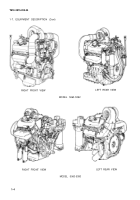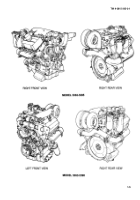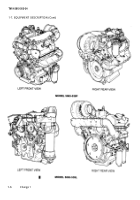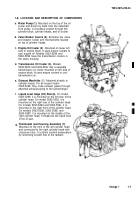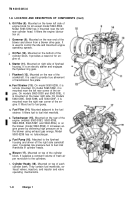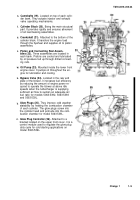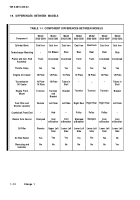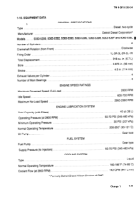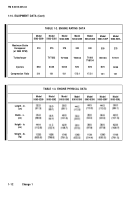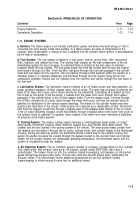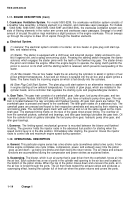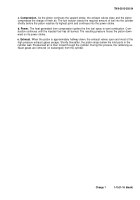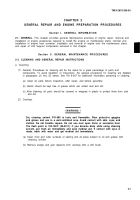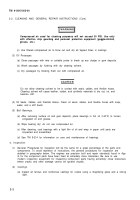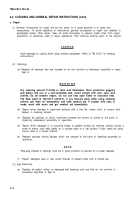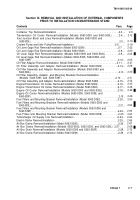TM-9-2815-205-34 - Page 26 of 596
TM 9-2815-205-34
1-11. ENGINE DESCRIPTION (Cont)
f. Crankcase Ventilation System.
For model 5063-5299, the crankcase ventilation system consists of
a breather tube assembly, a filtering element in a collector, and crankcase vapor passages. For models
5063-5392, 5063-5393, 5063-5395, 5063-539F and 5063-539L, the crankcase ventilation system con-
sists of filtering elements in the rocker arm covers and crankcase vapor passages. Seepage of a small
amount of air past the piston rings maintains a slight pressure in the engine crankcase. This air sweeps
up through the engine to draw off oil vapors through the breather elements.
g. Electrical System.
(1)
General.
The electrical system consists of a starter, air box heater or glow plug cold start sys-
tem, and related wiring.
(2)
Starter.
The starter is equipped with a shift lever and solenoid plunger, totally enclosed to pro-
tect it against dirt, and a sprag overrunning clutch, Pressing the starting switch energizes the starter
solenoid, which engages the starter pinion with the teeth of the flywheel ring gear. The starter drives
the pinion and rotates the engine. When the engine begins to operate, the sprag clutch permits the
pinion to overrun on its shaft until the starting switch is released, which prevents overspeeding of the
starter.
(3)
Air Box Heater.
The air box heater heats the air entering the cylinders to assist in ignition of fuel
at low ambient temperatures. A fuel and air mixture is sprayed into the air box and a spark ignites a
flame. The flame heats the incoming engine air which is fed directly into the cylinders.
(4)
Glow Plug Cold Start System.
The glow plug cold start system is an alternative means to assist
in engine starting at low ambient temperatures. It consists of glow plugs, which are installed in the
cylinder heads, and a controller that regulates the starting cycle and preglow/afterglow duration,
h. Gear Train.
The gear train consists of a crankshaft gear, idler gear, fuel pump drive gear, and two
camshaft gears. Models 5063-5393 and 5063-539L, also have a hydraulic pump drive gear. The ear
train is located between the rear end plate and flywheel housing, All gear train gears are helical. The
crankshaft gear is pressed and keyed to the crankshaft. The idler gear rotates on a stationary hub. The
camshaft gears are pressed and keyed to their respective camshafts and secured by their retaining nut
and locking plate. The camshaft gears mesh with each other and run at the same speed as the crank-
shaft gear. The stamped timing marks on the face of the gears show proper timing, The overflow oil
from the camshaft pockets, camshaft end bearings, and idler gear bearings lubricates the gear train, Oil
from the cylinder block oil gallery lubricates the fuel pump drive gear, hydraulic pump drive gear, and
idler gear bearings.
i. Governor.
The limiting-speed, mechanical governor is mounted between the blower and flywheel
housing. The governor holds the injector racks in the advanced fuel position for starting when the
speed control lever is in the idle position. Immediately after starting, the governor moves the injector
racks to control idle and maximum engine speed during operation.
1-12. OPERATIONAL DESCRIPTION
a. General.
This particular engine series has a two stroke cycle (sometimes called a two cycle). A two
stroke engine completes one cycle (intake, compression, power, and exhaust) every time the piston
goes up and down - up being one stroke and down being the return stroke. The air intake and exhaust
functions are accomplished during the compression and power strokes as explained below.
1-14
Change 1
b. Scavenging.
The blower, which is an air pump that is gear driven from the crankshaft, forces air into
the air box. Each cylinder has a row of ports in the cylinder wall opening to the air box and located at
the bottom of the piston stroke. When the top of the piston moves down and uncovers the ports, air in
the air box is forced through the ports. The air then flows toward the exhaust valves and produces a
scavenging effect, leaving the cylinder full of fresh air when the piston returns and covers the ports.
Back to Top

